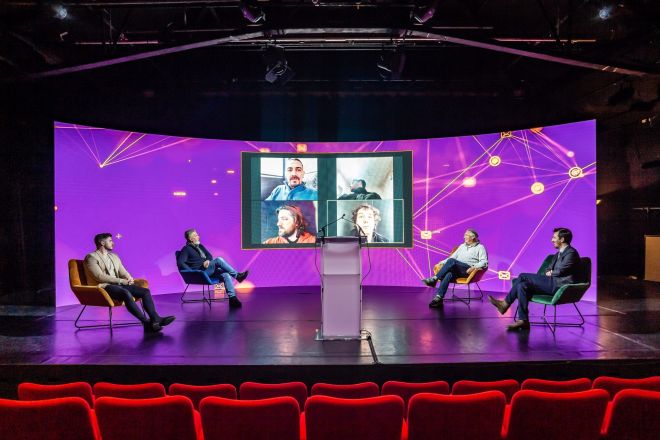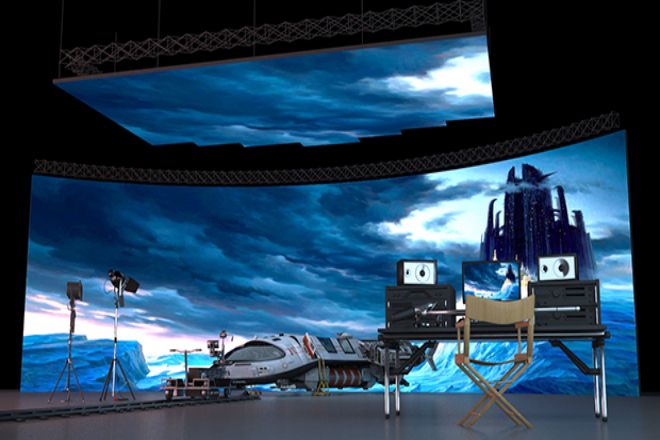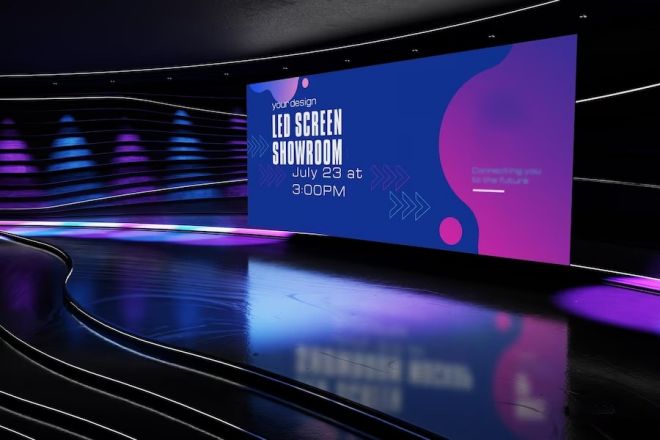Introduction

Today, as digital media becomes increasingly developed, LED display screens, as an efficient and flexible visual display tool, have penetrated into every aspect of our lives.
Especially in the special environment of the studio, LED display screens bring unprecedented viewing experience to the audience with their excellent performance and diverse applications.
1. Technical advantages of LED display screen
- Image quality clarity
The LED display screen can present a delicate and clear picture through a high-resolution pixel array. High resolution means more pixels are used to display images, allowing the details of the picture to be perfectly presented. Whether it is text, pictures, or videos, the high-resolution LED display can ensure its clarity and readability, bringing a more realistic visual experience to the audience.
- Color expressiveness
LED displays have significant advantages in color reproduction and saturation. Through advanced color processing technology, LED displays can accurately restore the color of the original image, ensuring color accuracy and authenticity.
At the same time, the high saturation characteristics of the LED display screen make the color of the picture more vivid, bringing a more shocking visual effect to the audience.
- Brightness and Contrast
The brightness and contrast of LED displays are another major technical advantage. In a bright environment, the LED display can maintain sufficient brightness to ensure that the picture is clearly visible.
In dark scenes, the LED display can show a higher contrast, allowing the dark details in the picture to be presented. This excellent brightness and contrast performance allows the LED display to maintain excellent display effects in various environments.
- Responding speed
The response speed of the LED display is the key to the smoothness of its fast dynamic pictures. Since each pixel of the LED display emits light independently, its response time is very short, and it can respond quickly and present rapidly changing images. This fast response speed enables the LED display screen to present a smoother and more natural picture effect when playing dynamic images, videos, and advertisements.
- Customization and flexibility
LED displays are highly customizable and flexible in shape, size, and installation location. Due to its modular design, the LED display screen can be customized according to actual needs; whether it is round, arc, or irregular shape, it can be easily realized.
At the same time, the size of the LED display can also be adjusted according to the size of the venue and viewing distance to ensure the best viewing effect. In addition, the installation position of the LED display is also very flexible and can be installed on the wall, floor, ceiling, etc., providing more possibilities for the layout of the studio.
2. Application scenarios of LED display screens in studios

- Background wall and stage scenery
LED display screens are widely used as background walls and stage scenery in studios. Through programming and control, LED displays can display various images, videos, and animations, providing rich and varied background effects for programs.
This flexibility and diversity make stage design more creative and attractive, helping to enhance the visual effects of the show and the audience experience. For example, in concerts, LED displays can display images and animations that match the rhythm of the music, creating a more immersive atmosphere.
In theatrical performances, LED displays can simulate various scenes and environments to help actors Express emotions and stories well.
- Real-time interaction and audience participation
LED displays can also be used for real-time interaction and audience participation in studios. By connecting to the Internet and social media platforms, the LED display can display messages, comments, voting results, and other content sent by the audience in real-time.
This interactive method not only increases the fun and interactivity of the program but also improves the audience’s sense of participation and belonging.
For example, in variety shows or talent shows, the LED display can display the audience’s voting results and comments in real-time, allowing players to establish a closer connection with the audience; in concerts, the LED display can display the audience’s real-time barrage and photo walls, allowing the audience to be more immersed in and enjoy the music feast.
- Virtual Scenes and Special Effects
Combining virtual reality (VR) and augmented reality (AR) technologies, LED displays can create immersive virtual scenes and special effects in studios. Through projection and mapping technology, LED displays can combine virtual scenes with real stages to bring a more realistic visual experience to the audience.
This technology can not only create various fantastic visual effects in program production but also provide viewers with a richer viewing experience. For example, in science fiction-themed programs, LED displays can simulate scenes such as space, planets, and the universe
In dance performances, LED displays can present flowing lines and light and shadow effects, echoing the movements and rhythm of dancers.
- Information release and advertising display
Set up LED displays inside and outside the studio, which can be used for real-time information release and advertising promotion. This application method can not only improve the utilization rate and visibility of the studio but also provide more exposure opportunities for merchants and brands.
By releasing program previews, event information, and advertising content, LED displays can attract more viewers to watch and participate. At the same time, the LED display screen can also be customized according to the program content and audience needs, improving the pertinence and effectiveness of the information.
For example, before a concert, the LED display can publish information such as the singer’s profile, song list, and performance time; during the event, the LED display can display the merchant’s brand logo, product information, promotions, and other content.
3. Strategies to improve the studio viewing experience
1). Creative content design
In order to improve the viewing experience in the studio, the content design of the LED display must be closely integrated with the theme and style of the program. Here are a few key points for creative content design:
- Color matching and theme echo:
Choose the appropriate color matching according to the program theme so that the content of the LED display screen echoes the program theme, creating a more harmonious and unified visual effect.
- The combination of dynamic effects and static images:
In content design, the combination of dynamic effects and static images can increase visual layering and appeal. Bring a more vivid visual experience to the audience through dynamic images, animations, and transition effects.
- Use of creative animation and video materials:
Use creative animation and video materials to enrich the content of the LED display and make it more attractive and expressive. These materials can be combined with program content to present a more exciting and interesting visual feast to the audience.
2). Technology integration and synchronization
In order to ensure the seamless connection between LED display screens and program playback, lighting, audio, and other equipment, technical integration and synchronization are crucial. Here are a few key points:
- Precise time synchronization:
Ensure that the LED display screen and program playback, lighting, audio, and other equipment are synchronized in time to avoid picture delays or misalignment.
- Efficient signal transmission and switching:
Advanced signal transmission and switching technology is used to ensure that the LED display screen can maintain efficient and stable performance when receiving and displaying content.
- Flexible control system and operating interface:
Design an easy-to-operate control system and operating interface with rich functions to facilitate staff to adjust the display effect of the LED display in real time according to program needs.
3). Audience perspective optimization
In the process of improving the viewing experience in the studio, the optimization of the audience’s perspective is a link that cannot be ignored. Here are a few key points:
- Consider the coverage of the audience’s sight:
According to the location and distribution of the auditorium, reasonably set the angle and height of the LED display to ensure that all audiences can get a good viewing effect.
- Balance the viewing effects at different locations:
Adjust the brightness and color of the LED display for viewers at different locations in the auditorium, so that it can present the best viewing effect at different locations.
- Adjust display settings based on audience feedback:
Collect audience feedback and adjust the display settings of the LED display in a timely manner to meet the audience’s viewing needs.
4). Real-time adjustment and feedback mechanism
In order to cope with possible changes and unexpected situations on site, it is crucial to establish a quick-response LED display adjustment system. Here are a few key points:
- Real-time monitoring of picture quality and effect:
Through professional monitoring equipment and technical means, the picture quality and effect of the LED display screen are monitored in real-time to ensure that it is always maintained in the best condition.
- Set up a professional team for on-site debugging:
Set up a professional technical team to be responsible for on-site debugging and maintenance work to ensure that the LED display screen can operate stably during the performance.
- Collect opinions and suggestions from audiences and experts for improvement:
Collect opinions and suggestions from audiences and experts, improve and optimize problems, and continuously improve the application effect of LED display screens in studios.
4. Future prospects

- The development trend of LED display technology in the studio field.
The application of LED display screens in the studio field will continue to expand and deepen. With the continuous advancement of technology, there will be a more diversified, higher quality, and more intelligent development trend.
In the future, LED displays will pay more attention to the integration with performing arts content and bring more shocking and realistic visual effects to the audience through innovative design and technology applications.
At the same time, with the continuous development of intelligent technology, LED displays will achieve higher levels of automated control and intelligent management, improving the operating efficiency of the studio and the audience’s viewing experience.
- The impact of new technologies (such as 5G, 8K, etc.) on LED display screens in studio applications
The continuous emergence of new technologies will bring revolutionary changes to the application of LED displays in studios. For example, the application of 5G technology will greatly improve the speed and stability of data transmission, making high-definition, real-time, and large-capacity video transmission possible.
This will provide richer and more diverse content resources for LED display applications in studios and achieve higher-quality picture display. At the same time, the promotion of 8K technology will further improve the picture quality and clarity of LED displays, making the picture details richer and more realistic, bringing a more shocking viewing experience to the audience.
- The importance of continuous innovation and technological upgrading in improving the studio viewing experience
Continuous innovation and technological upgrades are crucial to improving the studio viewing experience. With the continuous advancement of technology, the performance of LED displays will continue to improve, and new application scenarios and ideas will continue to emerge.
Through continuous innovation and upgrading of technology, the application of LED display screens in studios can be made more diversified and flexible, bringing a more colorful viewing experience to the audience. At the same time, innovation will also promote the continuous progress and development of LED display technology, bringing more opportunities and challenges to the studio field.
Conclusion
With the continuous advancement and innovation of technology, the application of LED display screens in the studio field will become more and more extensive. Through creative design, technology integration, and optimization of audience perspectives, we can create a studio that is both visually impactful and artistic.
This is not only an innovation in the audience’s viewing experience but also an important promotion for the performing arts and media communication industries.
Finally, if you want to know more information about LED displays, please get in touch with us.
